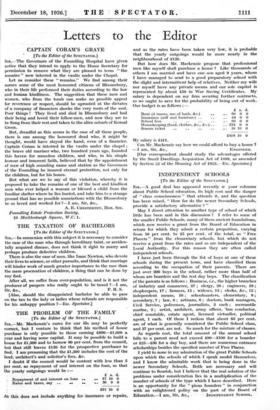INDEPENDENT SCHOOLS
[To the Editor of the SPECTATOR.] Sia,—A good deal has appeared recently ir your columns about Public School education, its high cost and the danger of " class consciousness " that attends it, and the question has been raised, " How far do the newer Secondary Schools, provide a satisfactory alternative ? "
May I direct attention to another type of school of which little has been said in this discussion ? I refer to some of the smaller Public Schools, many of them ancient foundations, which now receive a grant from the Board of Education in return for which they admit a certain proportion, varying from 10 per cent. to 25 per cent. of the total, as " Free Placers " from the elementary schools, but which do not receive a grant from the rates and so are independent of the Local Authority. For this reason they are often called independent schools.
I have just been through the list of boys at one of these schools during the present term, and have classified them according to the occupation of their parents. There are just over 200 boys in the school, rather more than half of whom are boarders and the rest day boys. The classification of the parents is as follows : Business, i.e., the higher branches of industry and commerce, 37 ; clergy, 26 ; engineers, 18 ; shopkeepers, 17 ; farmers, 15 ; widows, 15 ; clerks, &c., 12 ; independent means, 10 ; schoolmasters, elementary, 9 ; secondary, 7 ; law, 8 ; artisans, 6 ; doctors, bank managers, Civil Service, policemen, journalists, 3 each ; mercantile marine, 2 ; artist, architect, army officer, 'bus conductor, chief constable, estate agent, licensed victualler, political agent, 1 each. Of these I reckon that about 63 per cent. are of what is generally considered the Public School class, and 37 per cent. are not. So much for the mixture of classes.
As regards cost, the total amount of the annual school bills to a parent need not exceed £90--£100 for a boarder or £25—£30 for a day boy, and there are numerous entrance scholarships besides the specified number of Free Places.
I yield to none in my admiration of the great Public Schools upon which the schools of which I speak model themselves, and I know the admirable work that is being done in the newer Secondary Schools. Both are necessary and will continue to flourish, but I believe that the real solution of the problems under consideration lies in a multiplication of the number of schools of the type which I have described. Here is an opportunity for the "pious founders" in conjunction with an enlightened -policy on the part of the Board of
Education.—I am, Sir, &c., - INDEPENDENT SCHOOL.










































 Previous page
Previous page